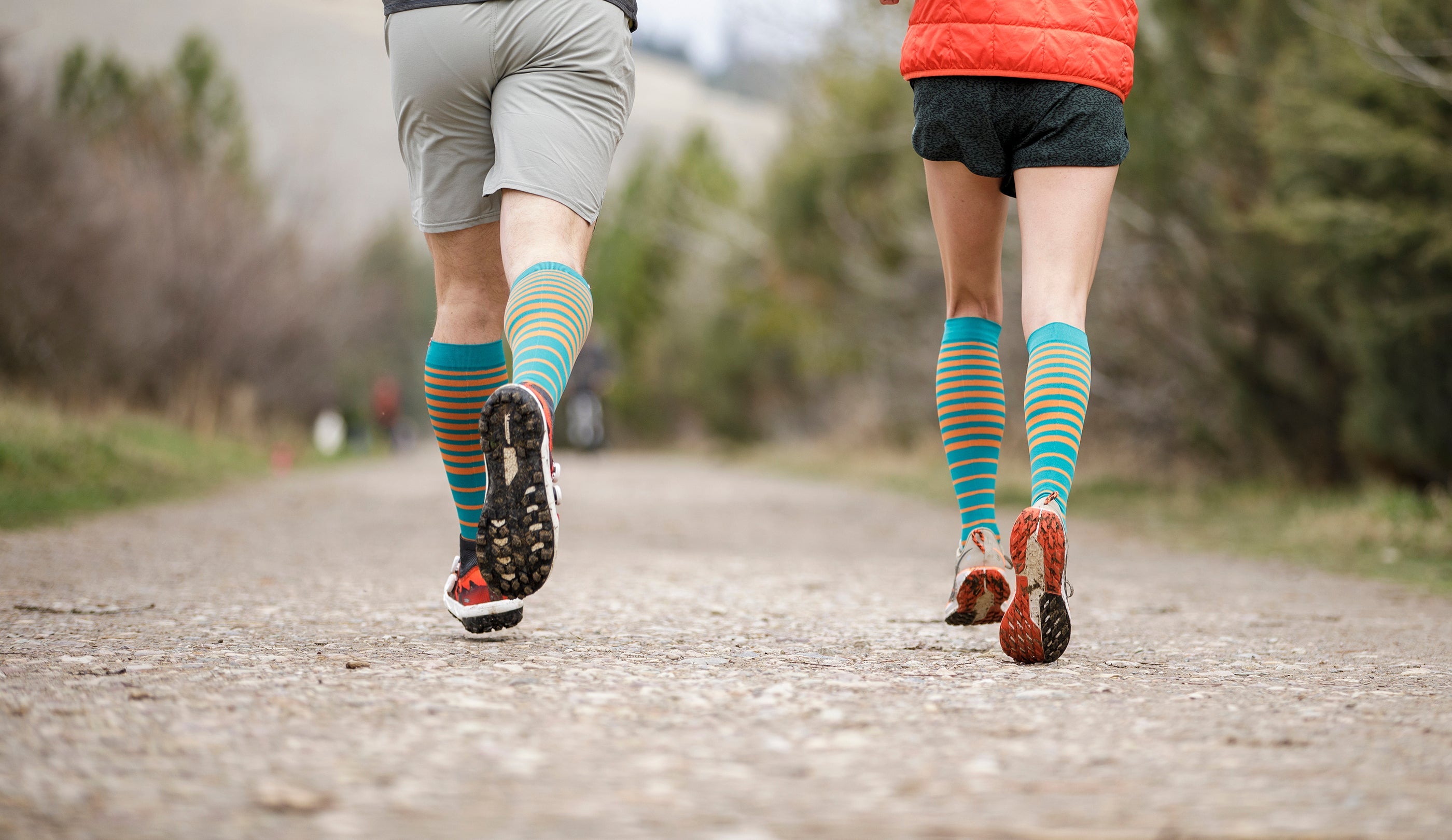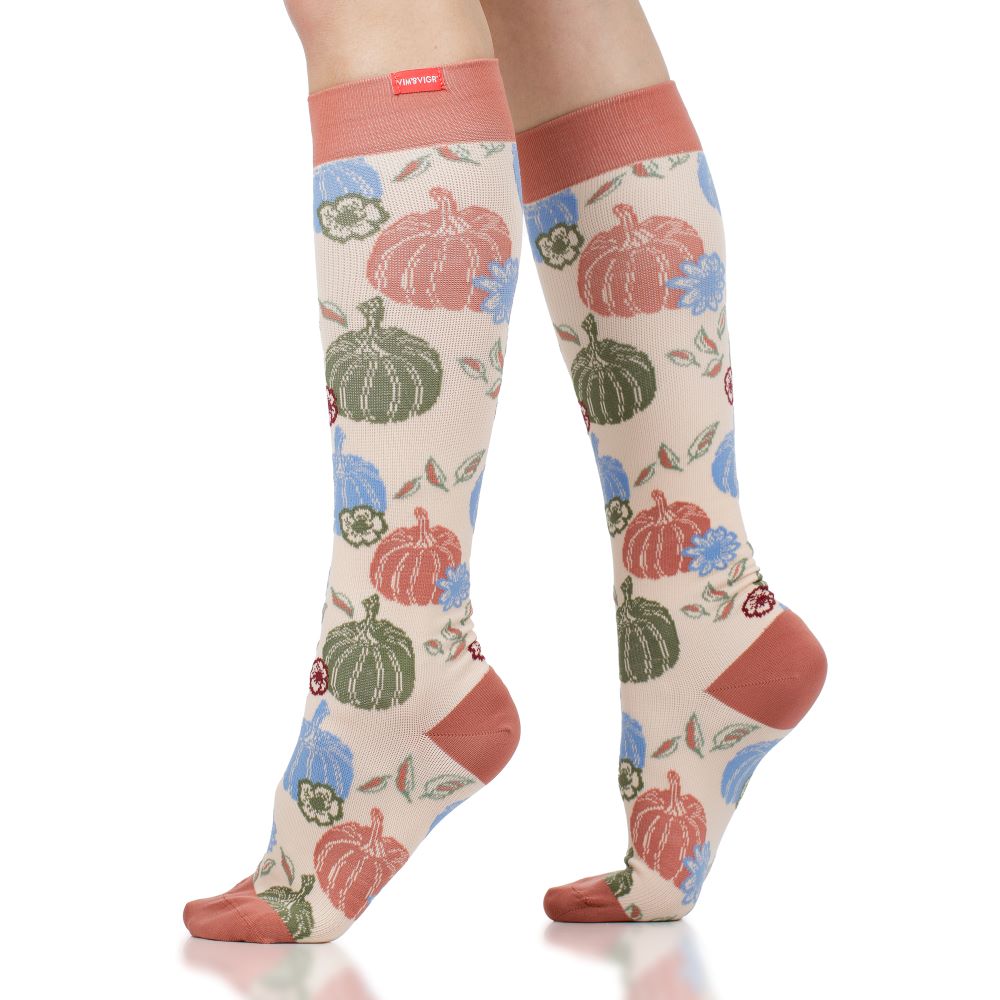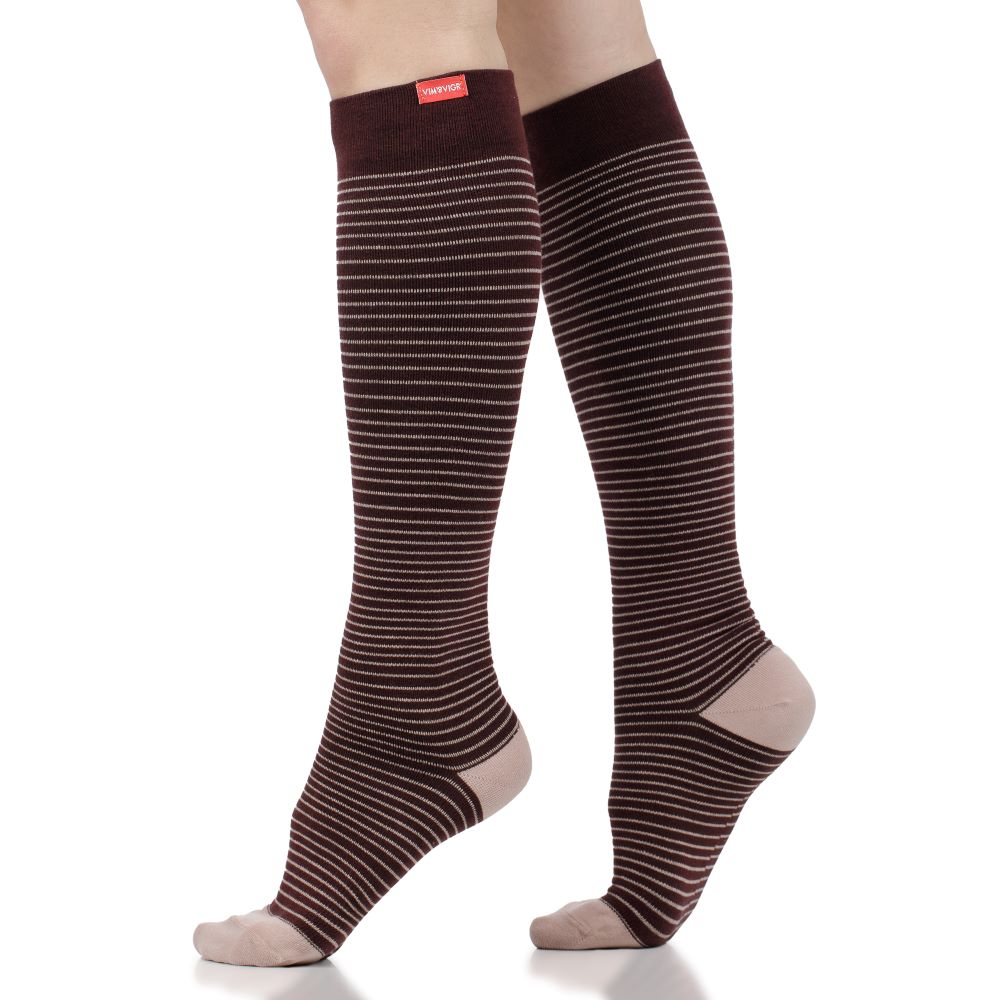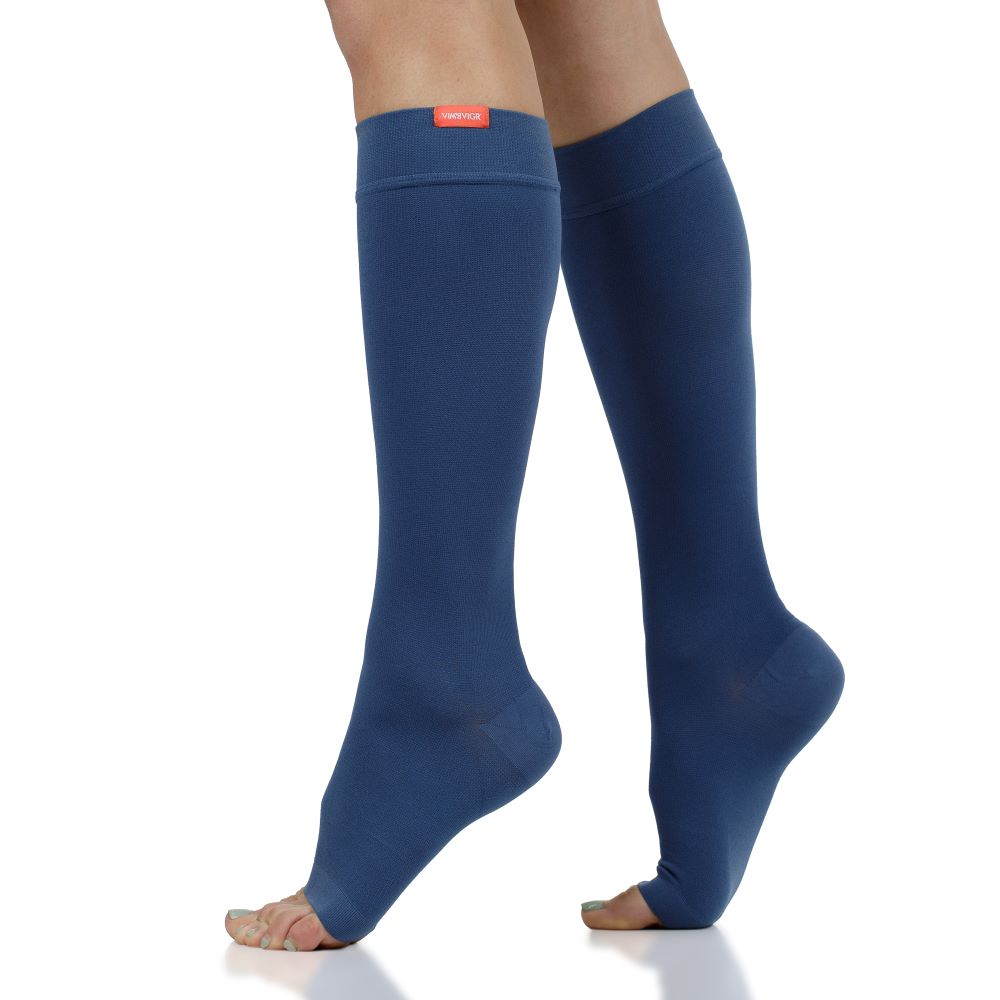Should You Wear Compression Socks During Exercise?
When you think about working out, you’re probably looking to optimize your results without feeling too sore afterwards. Who hasn’t dreaded the famous delayed onset muscle soreness and stiffness you get the day after hitting the gym after a break? And, if you’re a runner, a biker, or a dancer, you might have struggled with swollen ankles and feet, too!
Science shows that compression socks are an essential part of an athlete’s toolkit. They help boost blood flow to the lower legs, ensuring you don’t get swelling and soreness around your calves, ankles, shins, and feet. They can delay the onset of fatigue and pain during workouts and they’ll help you recover quicker afterwards.
So, should you wear compression socks during exercise? Thanks to how they support blood circulation and the muscles in the lower legs, compression socks can be extremely beneficial while you exercise.
In this article, we’ll see how safe it is to wear compression socks while exercising, how they work on your muscles and circulatory system, their benefits, and the best way to benefit from them during and after working out.
Should I Wear Compression Socks While Exercising? Is it Safe?
As long as they fit you correctly, there are no dangers to wearing compression socks while exercising. Certain workouts will make you feel their effects more than others, but, generally, wearing them provides multiple benefits:
- Boost in blood flow so you have less of a risk of swollen ankles and feet;
- Additional support to joints and muscles;
- Reduction of micro vibrations that travel up the leg from impact;
- A pleasant, slight massage of the calf muscles and shins;
- Better and quicker recovery after workouts.
We’ll go into more detail on each of these below.

How Compression Socks Work During Exercise
The key way in which compression socks work on the lower legs is by boosting blood circulation in the area. Graduated compression socks apply more pressure towards the ankle and foot, slowly decreasing it upwards towards the knee. This stimulates blood flow upwards and back towards the heart. As a result, there is less of a risk of blood and fluid pooling around the ankles. First and foremost, this means less swelling and discomfort.
Additionally, the tight hold of compression socks on the leg muscles provides welcome additional support while you work out. Whether you’re returning to exercise after an injury or ramping up the intensity of your workouts, it feels good to know that jumps, sideways movements, and even some heavy lifting won’t take too much of a toll on your muscles.
It’s important to know that compression socks have post-workout benefits, too. Through the improvement in blood flow, they promote better and quicker delivery of oxygen and nutrients to the muscles. Studies show that this leads to shorter recovery times, helping reduce muscle soreness and irritation. You can go back into the gym sooner and feel fresher, too.
Benefits of Wearing Compression Socks During Exercise
Through improved blood flow and better support for muscles and joints, compression socks contribute to keeping your legs fresher during exercise. They can reduce the buildup of fluid and lactic acid in the lower legs, while also diminishing the risk of injuries and conditions like blood clots.
Improved Blood Circulation
While there are less strong links between performance improvements and the wearing of compression socks, one thing is certain: they improve peripheral circulation. This can be essential if you’re working out while pregnant or at risk of blood clots, as well as when you’re just starting out.

With better blood flow comes faster delivery of oxygen to the muscles. This can reduce the soreness you feel during working out. You’re also at a lower risk of various injuries and circulatory conditions. Finally, through the increase in circulation, exercise compression socks also help prevent swelling and discomfort that can affect your post-workout wellbeing.
Reduced Muscle Fatigue and Soreness
When we work out, we place stress on the muscles in order to stimulate them to develop. This can lead to soreness and fatigue, which is absolutely normal as part of exercise. However, wouldn’t it be nice if you could reduce both these feelings to an extent?
Compression socks help optimize blood flow in the lower legs. They therefore help the muscles get oxygen and nutrients faster and more efficiently, during exercise and afterwards. This is essential for their recovery, so if it goes on during a workout, we can infer that it contributes to holding off fatigue and pain from setting in.

Prevention of Swelling and Edema
Through the pressure they apply on the legs, compression socks help the blood travel back to the heart, without pooling around the ankles. This reduces the likelihood of swelling - from a minor swollen ankle to edema and even conditions like deep vein thrombosis.
Injury Prevention and Support
When working out, we’re placing an amount of stress on the body. For the lower legs, there is a lot of impact on the joints and muscles, while also the risk of developing medical conditions linked to blood circulation.
Compression socks hold on tightly to the muscles and joints. This improves stability and can help significantly when you’re back from an injury. They will also help give you a psychological boost as you know that you’re reducing the risk of another ankle sprain or of getting shin splints.
Finally, if you suffer from a circulatory condition and want to work out, you may be worried about the impact of sports on DVT or varicose veins. While you should always check with a medical professional, it can be beneficial to wear compression socks while exercising if you suffer from these conditions. Thanks to the blood flow support you get from them, you’ll reduce the risk of them worsening while supporting your circulatory system in general.
What are the Benefits of Wearing Compression Socks After a Workout?
Many athletes swear by compression socks for recovering after their workouts. This is because of their benefits to blood circulation. Here’s how they help:
- Boosting blood flow means that the leg muscles get more oxygen and nutrients delivered to them on an ongoing basis. You end a workout less sore than you would have been otherwise (assuming you wore the socks during exercise). And you get the benefit of better recovery after the workouts;
- Gentle massage of the leg muscles makes them feel lighter and helps reduce soreness and inflammation;
- The boost in circulation also helps reduce swelling and soreness once you’ve stopped training.
Since they speed up your recovery, compression socks help you return to training sooner and feeling fresher. Over time, this will improve your overall performance, since training in better shape can only help you gain fitness quicker!

Are There Any Specific Exercises Where Compression Socks Are Highly Recommended?
Exercise compression socks squeeze the foot, the ankle, and the lower legs up to the knee. This means that they are most beneficial for exercises where these parts of the body are used the most:
- Jumps and burpees;
- Playing sports like tennis or basketball;
- Lifting weights targeting the calf muscles in particular;
- Dancing, Pilates, yoga.
Additionally, better blood flow in the lower legs leads to an improvement in blood circulation throughout the body. This is why the benefits of compression socks don’t just extend to the lower legs - they can help boost energy levels and reduce pain and swelling in the whole body.
Wearing Compression Socks Correctly During Exercise
To get all the benefits of wearing compression socks while you work out, you need to ensure you wear them correctly and that you take good care of them.
When to Wear Compression Socks for Exercise
You can wear your favorite socks during your workouts to feel supported while you jump, move, and squeeze your muscles. You’ll also feel a slight massage, which can increase how comfortable you are during high-intensity exercise.
While wearing compression during effort has had mixed reviews and relies mostly on anecdotes from athletes about how good they feel, there is evidence that wearing these garments during recovery will benefit everyone. Put on your graduated compression socks after you’ve done a hard session at the gym and let them massage your aching muscles, while delivering those all-important nutrients and oxygen to them so they recover faster.
How Long to Wear Compression Socks for Exercise
You can wear compression socks for exercise recovery after a session, throughout the day, for as long as you feel comfortable. There are no strict timescales around how long to keep them on, but we do advise that you listen to your body and also ease yourself into compression wear gradually.
That means that, if it’s your first time wearing compression socks, it’s a good idea to only keep them on for 2-3 hours at first. Then, as you get used to them, you can increase this time as you feel comfortable.

Caring for Exercise Compression Socks
Your socks will stay tight for longer if you take good care of them after every wear. We recommend washing compression socks with a mild detergent (definitely no bleach!) and letting them dry naturally (the dryer will damage them).
It’s good to wash your socks every time you wear them to reduce potential damage to the fibers from moisturizer or sweat. Additionally, take care when you put them on so you don’t stretch them too much. Follow this guide for all the instructions you need!
Choosing the Right Compression Socks for Exercise
Exercise socks need to fulfil a few more criteria than the ones you wear every day. You’ll need moisture-wicking, breathable materials to ensure your feet don’t stay really sweaty throughout your workout. You may also want to choose different designs and styles, depending on your sport and personal preference.
Material
The fabric is the most important choice for good workout socks. While cotton is good for everyday wear, it’s not as breathable and it tends to keep moisture in. So, ditch the regular cotton socks for one of the following:
- Nylon - breathable and sleek, nylon compression socks are designed to move with you and feel comfortable, yet tight;
- Merino wool - keeping your feet dry in all kinds of weather, with the added benefit of temperature regulation so you never feel too warm or too cold.
Type and Style
Knee-high socks are the most popular, but you can benefit from compression therapy by wearing a few other styles on your lower legs. These include:
- Compression tights or leggings - for fuller coverage and extra support to the knees and thighs.
Compression Level
Not all compression socks are the same. Measured in mmHg, the compression level can vary from lighter, easy to wear all day, to medical grade, prescription-only. For most workouts and activities, you can wear moderate compression (15-20 mmHg), which will provide a gentle massage and medium-level squeeze of the lower legs.
Those who suffer from varicose veins or know themselves to be at risk of blood clots or other medical conditions will prefer firmer compression levels, such as 20-30 mmHg. These are usually prescribed by doctors when recovering from surgery or injury, as well.
There are also prescription-only compression socks at 30-40 mmHg, but these may feel too tight and restrictive to wear to the gym or to an exercise class.
Sizing and Fit
The final piece of the puzzle when picking exercise compression socks is ensuring they fit right. It’s easy to think these socks should be really tight, when in fact that runs the risk of cutting off your peripheral circulation and getting uncomfortable really quickly. To avoid numb feet in the gym, use our detailed sizing guide to make sure you wear socks that are appropriate for your activity.

How do you know if your compression socks fit well? You should feel a firm hold on your legs, without so much pressure that you cannot move freely. If you’re wearing knee-high socks, these need to reach just below the knee. They should also fit well around your toes and heel, without any extra material that can bunch and move around. Finally, ensure your socks are smooth against the skin, without any bunching or knots.


















Leave a comment